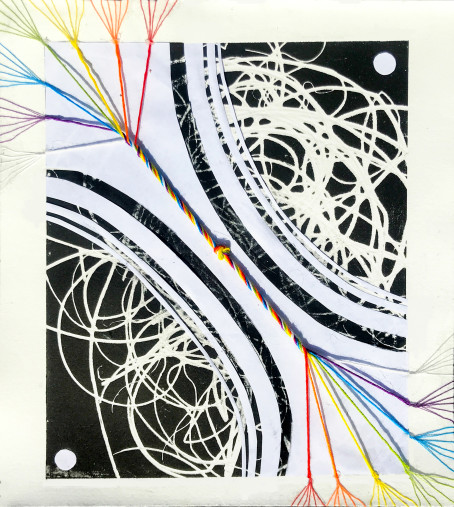Jannessa Alexandre ’24

Passage Selection: “Light-Skinned Girls and Kelly Rowlands” by Alexa Arthurs
“This assignment is what I call a ‘passage selection.’ Students pick any length excerpt from the assigned reading and react in a page or two. They transcribe their chosen excerpt at the top of the page, and then they get into their reaction. Some students pick a sentence or two, and some choose a longer excerpt; it’s up to them. They are encouraged to engage deeply with the excerpt, and to try to tie it to any themes that they notice in the text. These assignments take place before we’ve had any discussion of the reading in class, so the students are reacting honestly and personally, and without the benefit of any explication from me or impressions from their classmates.”
Selected excerpt: “I’d seen ahead. I’d had some sense of the consequences but I’d said what I said anyway. In part because I meant it and in part because I wanted to hurt Cecilia for complicated reasons including the fact that she seemed to carry a lighter burden on her back. She could forget herself. She would graduate without loans because her parents could afford to pay for her tuition. She could want to sleep with a white man and that desire came as a clean feeling. I envied her for reasons that weren’t even her fault. When Cecilia walked away from me, I don’t know why I was surprised. I only know that I was. I stood there on West Seventy-second, waiting and hoping that she would turn around, but I was too stubborn and maybe even too stupid to make any attempts at winning back my best friend’s favor. And anyway, I don’t know what I would have said” (Arthurs 13).
*
Alexa Arthurs’ “Light Skinned Girls and Kelly Rowlands” was an overall compelling personal narrative that conveyed the issue of deeply-ingrained oppression, and particularly how black people internalize that oppression. Initially, I thought that this story was going to focus on the issue of colorism based on the title, and there were mentions of complexion and racial phenotypes throughout the story (Arthurs 1). The first paragraph introduces how darker-skinned black women are only praised if they meet certain beauty standards and/or have a level of sex appeal. These standards usually range from facial structures, hair types, and body types—curvaceous, slimming, etc.
The ‘Kelly Rowland’ lyric was an amazing choice for this story because it cements the idea of dark-skinned black women being negatively affected by the colorism that is prevalent in the music industries and the media, and how women may internalize those messages and attempt to live up to those dehumanizing standards.
However, the story mainly focuses on two characters from different upbringings and environments finding solidarity and a friendship together. Kimberly, the narrator and main character, was originally from Jamaica and came to New York when she was six years old. Cecilia is Jamaican but, unlike Kimberly, was born and raised in California. Cecilia’s parents are both present and able to provide for her. Kimberly only had her mother, who wasn’t making nearly the same earnings. Even as Kimberly and Cecilia bond over their creative interests and their heritage, they are still faced with many disagreements because they were raised differently. Kimberly seems to be more conscious, and cherishes her identity as an immigrant black woman, having more opinions in the conversation of systemic oppression. These are things that Cecilia doesn’t understand entirely because she was born into an environment where the issue of people being marginalized is minimized, masked by a false sense of inclusivity. This is probably why she doesn’t see anything inherently wrong with courting outside of her race and only using a black man when it is convenient for her. This was also why she felt embarrassed whenever Kimberly would bring up anything that had to do with racial issues.
The selected quote is important in terms of understanding Kimberly and Cecilia’s dynamic, and it highlights Kimberly’s flaws and her innermost character. Not only was Kimberly irritated with Cecilia for not understanding that there are heavy racial implications for using Troy, a black man, for selfish concerns (getting a reaction and subsequent reconciliation from her white ex-boyfriend Adam), Kimberly also seemed genuinely hurt and confused by this. She couldn’t fathom how someone who looked just like her couldn’t understand so many of the things she talked about. Kimberly factored in the differences in their experiences and realized that because Cecilia didn’t have to deal with assimilation in dialects, environments, and lifestyles, as well as in her being raised by both of her parents who provided her with enough to be successful, her views weren’t going to be the same. (Arthurs 13).
In the heat of that moment, Kimberly projected this frustration on Cecilia, who didn’t have to struggle in the ways Kimberly and her mom did. Kimberly cared for Cecelia and saw more in her than there actually was. “My close girlfriends, relationships forged back in high school, were the daughters of Caribbean immigrants, and they had left me lonely when we separated to attend different colleges. In college I’d met people I studied with and hung out with on occasion, but I hadn’t really had a bosom friend till Cecilia(…) Around Cecilia I was more beautiful. Sometimes she would look at me and say, “You’re so pretty,” and coming from her it felt true”(Arthurs 6,8).
Being around Cecelia made Kimberly feel seen and understood, but it’s possible that her expectations and idealization of Cecelia posed one the greater internal challenges in their relationship, and that is what makes this story so raw. These are the kind of experiences that I’ve come across and it opened new perspectives, and affects people in so many different ways.
Work Cited
Arthurs, Alexia. “Light Skinned Girls and Kelly Rowlands.” Shondaland. 23 July 2018, www.shondaland.com/inspire/books/a22504170/alexia-arthurs-how-to-love-a-jamaicane excerpt/, Accessed 1 Aug. 2019.